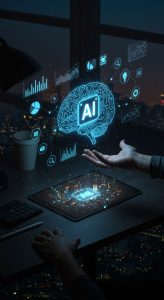 The Rise of Artificial Intelligence: Transforming Our World
The Rise of Artificial Intelligence: Transforming Our World
Artificial Intelligence (AI) is no longer just a futuristic concept confined to science fiction movies. It has become an integral part of our daily lives, driving innovation across industries, reshaping economies, and redefining how humans interact with technology. From powering recommendation systems on streaming platforms to enabling self-driving cars, AI is rapidly becoming one of the most transformative technologies of the 21st century.
In this blog, we will explore what AI really is, how it works, the areas where it is making the biggest impact, its challenges, and what the future might hold.
What is Artificial Intelligence?
At its core, Artificial Intelligence refers to the ability of machines to perform tasks that typically require human intelligence. These tasks include learning from experience, reasoning, problem-solving, understanding natural language, recognizing images, and even making decisions.
AI can be broadly classified into two categories:
Narrow AI (Weak AI) – This type of AI is designed for a specific task. Examples include voice assistants like Siri or Alexa, recommendation systems on Netflix, or spam filters in your email. Narrow AI dominates the current landscape and is incredibly effective within its boundaries.
General AI (Strong AI) – A theoretical form of AI that would perform any intellectual task that a human can do. General AI would have the ability to learn, adapt, and apply knowledge across domains. While researchers are making progress, this level of AI does not yet exist.
How Does AI Work?
AI works by using a combination of algorithms, data, and computing power. At the heart of most AI systems is machine learning (ML), a technique where machines improve their performance on a task by learning from data rather than following explicit instructions.
Key Components of AI:
Data: AI thrives on data. The more data an AI system has, the better it can learn patterns and make predictions. For example, a self-driving car learns to recognize pedestrians by analyzing millions of labeled images of roads and people.
Algorithms: These are sets of rules or instructions that guide AI systems on how to process data. Advanced algorithms like deep learning use artificial neural networks inspired by the human brain to achieve remarkable results.
Computing Power: The rise of powerful GPUs and cloud computing platforms has enabled AI to process massive amounts of data quickly, accelerating progress in fields like natural language processing and computer vision.
Applications of AI Across Industries
AI’s potential is vast, and its applications are already evident across multiple industries:
1. Healthcare
AI is revolutionizing the healthcare sector by enabling faster diagnoses, personalized treatments, and better patient care.
AI-powered diagnostic tools can detect diseases like cancer in medical scans with accuracy comparable to or even surpassing human experts.
Predictive analytics helps hospitals manage resources and anticipate patient needs.
Virtual health assistants provide 24/7 medical advice, reducing the burden on healthcare professionals.
2. Finance
In the financial sector, AI is used for fraud detection, risk assessment, and automated trading.
AI algorithms analyze massive datasets to detect unusual transaction patterns and prevent fraud.
Robo-advisors recommend investment strategies tailored to individual investors.
High-frequency trading systems leverage AI to make trades in milliseconds, maximizing profits.
3. Transportation
Self-driving vehicles are perhaps the most visible example of AI in action.
Companies like Tesla, Waymo, and Uber are investing heavily in autonomous driving technology.
AI optimizes traffic flow in smart cities, reducing congestion and improving safety.
Logistics companies use AI to predict demand and streamline delivery routes.
4. Retail
AI is transforming how businesses interact with customers.
Recommendation systems on Amazon or Netflix suggest products and content based on user preferences.
AI-powered chatbots provide instant customer support.
Retailers use AI for inventory management, demand forecasting, and personalized marketing campaigns.
5. Education
AI-powered learning platforms are personalizing education.
Adaptive learning systems adjust content difficulty based on a student’s performance.
AI tutors provide real-time feedback and guidance.
Educational institutions use AI to streamline administrative processes.
6. Manufacturing
In manufacturing, AI powers predictive maintenance, quality control, and process optimization.
AI models predict when machines are likely to fail, reducing downtime and saving costs.
Vision systems ensure product quality by detecting defects.
Robotics and AI work together to enhance automation and efficiency.
Everyday AI: Impact on Our Daily Lives
Even if you don’t realize it, AI already plays a significant role in your daily routine:
Unlocking your smartphone using facial recognition.
Using Google Maps to find the fastest route.
Interacting with virtual assistants like Siri, Google Assistant, or Alexa.
Getting personalized content recommendations on YouTube, Netflix, or Spotify.
Receiving targeted advertisements while browsing online.
AI has become so deeply embedded in our lives that many of us use it dozens of times a day without even noticing.
The Challenges and Risks of AI
While AI offers incredible opportunities, it also raises important challenges and ethical concerns.
1. Job Displacement
One of the biggest fears is that AI will replace human jobs. Roles involving repetitive tasks are especially at risk, such as data entry clerks, factory workers, and even some customer service roles. While AI may create new jobs, there is concern about whether displaced workers can reskill quickly enough.
2. Bias and Fairness
AI systems learn from data. If the data contains biases, the AI will replicate and even amplify those biases. For example, facial recognition systems have been shown to be less accurate in identifying people with darker skin tones. Ensuring fairness and inclusivity in AI is an ongoing challenge.
3. Privacy Concerns
AI relies heavily on data, often including personal information. This raises questions about how data is collected, stored, and used. Striking a balance between personalization and privacy is critical.
4. Security Risks
AI can also be used maliciously, such as in creating deepfakes or designing advanced cyberattacks. Governments and organizations must find ways to defend against AI-driven threats.
5. Ethical Dilemmas
Should an autonomous car prioritize the safety of its passengers or pedestrians in case of an unavoidable accident? Who is accountable if an AI system makes a harmful decision? These ethical dilemmas highlight the need for clear guidelines and responsible AI development.
The Future of AI
Looking ahead, AI’s role will only expand, with both exciting possibilities and significant responsibilities.
1. AI and Human Collaboration
The future is not about AI replacing humans, but about AI augmenting human capabilities. For example, doctors will use AI tools to make better diagnoses, but the final decision will still involve human judgment.
2. AI in Creativity
AI is already creating music, writing articles, and generating digital art. In the future, AI may become a true collaborator in creative fields, sparking new forms of human expression.
3. General AI
While still theoretical, researchers continue to work toward developing AI that can reason, learn, and adapt like humans. If achieved, General AI could fundamentally reshape society — though it also raises profound ethical and existential questions.
4. Responsible AI Development
Governments, businesses, and researchers are increasingly emphasizing the need for ethical AI — systems that are transparent, fair, and accountable. Policies and regulations will play a crucial role in ensuring AI benefits humanity as a whole.
Conclusion
Artificial Intelligence is not just another technological trend; it is a profound shift that is reshaping how we live, work, and interact with the world. From healthcare to finance, education to transportation, AI is driving innovation and unlocking possibilities that were unimaginable a few decades ago.
Yet, with great power comes great responsibility. Ensuring AI is developed ethically, inclusively, and responsibly will determine whether it becomes a tool for progress or a source of harm.
One thing is certain: AI is here to stay. As individuals, professionals, and societies, we must embrace the opportunities it offers while carefully navigating the challenges it presents. The future of AI is not about machines replacing humans — it is about humans and machines working together to build a smarter, more efficient, and more equitable world,
There is no gallery selected or the gallery was deleted.

